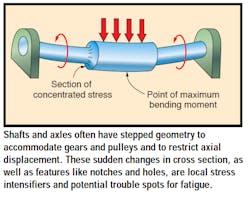Often, rigidity is a primary concern. Shafts that are too ductile can deflect and misalign, subjecting gears and bearings to excess slop and wear. Where stiffness, not strength, is a priority, less expensive materials like lowgrade steels are often sufficient.
When strength is the issue, the geometry and material must be figured for duty beyond mere static loading and torque transmission with the occasional torque spike. Axles and shafts can bend under transverse loads and when operating between misaligned machinery. This sets up classic conditions for fatigue, as the spinning axial "strands" undergo alternating flexural compression and tension with each revolution. And torsional fatigue is also a concern, particularly in drive shafts that undergo frequent start-stop and reversal.
Speed adds further complications. A rotating part must be built so it doesn't operate near its critical speed. Due to imperfect fabrication, the center of mass of any axle or shaft is offset (if only slightly) from the axis of rotation. As speed increases, centrifugal force exaggerates the eccentricity, pulling outward on the shaft. At critical speed, the shaft resonates, vibrating over or even whirling around the rotation axis, and the displacement amplitude can rapidly become destructive. The critical speed is very close to the lateral natural frequency, although dynamic factors can set them apart a bit.
Torsional resonance is also to be avoided. Torque fluctuations and disturbances in a drive shaft can occur at the torsional natural frequencies.
Questions & answersQ. What's the difference between a shaft and an axle?
A. There are several schools of thought on this. One states that "true" axles are merely static rods that support rotating members, and only shafts transmit power and motion. Another defines an axle as any wheel support, whether or not it transmits power and motion, while a shaft accepts and drives gears, pulleys, sprockets, and other rotary power elements.
Q. What support do bearings offer an axle or shaft?
A. Bearing end conditions are a complex and crucial factor in shaft behavior. Bearings that allow the shaft to pivot under a transverse load make for easier shaft bending and a lower lateral natural frequency. From another standpoint, soft or loose end supports allow radial movement of the shaft centerline, so the shaft can resonate yet remain straight. Prohibiting this radial end movement forces the shaft to flex under resonance, and raises the critical speed.
Q. Can a shaft be pushed safely beyond the first critical speed?
A. Yes. In some machinery, shafts are designed to accelerate quickly past one or more resonance frequencies to reach operating speed. Significant bearing damping is helpful when moving through these critical speeds. Above the first critical speed, rigid shafts sometimes become flexible.
About the Author
Elisabeth Eitel
Elisabeth Eitel was a Senior Editor at Machine Design magazine until 2014. She has a B.S. in Mechanical Engineering from Fenn College at Cleveland State University.


